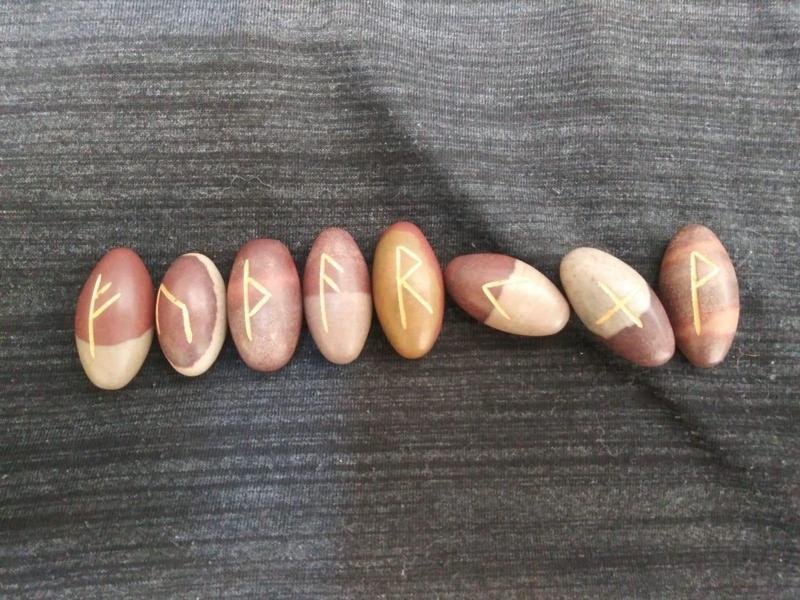Freyja's Aett
Freyja's Aett
It goes without saying that the most crucial parts of my practice are the Runes themselves. As previously stated, I use the Elder Futhark for its completeness as an esoteric system, but others exist, such as the Younger and the Anglo-Saxon, as well as the Armanen, which I consider as more supplementary than a standalone Futhark. The Elder Futhark is so-name for the first six Runes in its sequence, much like how the Alphabet is named for its first two letters, and is divided into three sets of eight, or “Aettir”, for a total of twenty-four Runes. Each Aett is given a name which corresponds with the first Rune in sequence, though there is no real orthodoxy to the exact names are they are purely mnemonic devices.
Interpreting the Runes is a tricky process, as there’s a complexity to symbolic language which absolutely requires cross-disciplinary study in order to fully utilise, in addition to lengthy and obsessive meditation on each Rune ad nauseam. It’s also crucial that one examine the meanings of each Rune in the same way that the ancient peoples who first used the Runes would have viewed such concepts, not necessarily in superstitious context, but in the hyper-practical way a true nature-worshiping tradition would engage them. They are quite compatible with any spreads commonly used in tarot, and in fact I tend towards the Cross spread most often, though I am open to using others, such as a simple three-Rune “past-present-future” spread or even drawing a single Rune to answer a single question. A point of contention among those who use the Runes is that of the inverse or “Merkstave” position, which is said to imply a negative or inverted state. I personally use Merkstave, as it clarifies what would otherwise be a vague reading, though there is no right or wrong in this case. Additionally, I have removed the blank from my set, as it is simply redundant and thus unnecessary in my opinion, which will be explored in greater detail when I get to the Rune which serves the purpose attributed to the blank.
As a final note before I begin with the first Aett, the observant will notice something peculiar about my Runes. I will leave the reader to solve this puzzle, as it is key to certain insights about the nature of Wotan that I think many overlook.
Freyja’s Aett
FEHU – phonetic F, representing cattle, wealth, assets to be carefully cultivated and tended to, spent only when in need. Unlike modern attitudes in regards to livestock, ancient peoples were reverent of those animals in their care, cattle being producers of food in the form of milk, and they would continue to provide so long as they were well-maintained. For as long as cattle were kept, one had wealth of sorts, in the form of a reliable food source, as well as a source of other goods such as leather and meat. Thus, Fehu is not just wealth, but the mindfulness which is able to create and sustain it.
URUZ – phonetic U, representing a large neolithic bull. I consider this Rune to be a hint of pre-civilisation traditions and lore, as the earliest believed instances of the domestication of the animal represented by Uruz, the Aurochs, date back to about 11,000 BCE. Uruz is something strong, physically healthy, stable. An earthy, grounded Rune.
THURS – phonetic TH, representing Thor and his struggle against the Jotnar, also called Thursar in some contexts (this is a subject of fascination for me and entire articles could be written just exploring these primordial giants). Thurs is conflict, harm, pain. The Anglo-Saxon poem for Thurs describes it as a “thorn” which at first seems nonsensical, until one considers what exactly a thorn’s purpose is – a small, vicious thing defending a frail plant against one who intends to harm it. Thurs is thus the conflict between a superior aggressor and a lone defender.
ANSUZ – phonetic A, representing wisdom, language, a god – more accurately, Wotan. Not so much knowledge, but the meta-knowledge to properly utilise knowledge. Intellect doesn’t just gather information, but instead gathers the means to use information most effectively, which is to say, wisdom. There is far too much data out there for anyone to ever take it all in, and so the real prize in one’s own mental faculties.
RAIDO – phonetic R, representing travel and the hardship thereof. In modern times, the means to travel quite easily over long distances is taken for granted, but back thousands of years ago, even a journey of maybe a hundred miles was not something undertaken lightly, requiring no small amount of preparation, and while en route, all number of things could go wrong which either impeded progress or halted it altogether.
KENAZ – phonetic K/C, representing a torch, knowledge. The distinction between Kenaz and Ansuz is vital, as the former without the latter is quite literally handling a torch without wisdom. It is knowing the inherent qualities of the world around oneself and the various reactions which can occur, though these reactions can prove destructive and catastrophic if initiated without thought.
GEBO – phonetic G, representing marriage, a gift, sex. The general themes of Gebo are that of an equal exchange, “this for that”. Something fair and balanced, as agreed upon by the parties involved.
WUNJO – phonetic W/V, representing joy and satisfaction. Nothing so simple as instant gratification or a fleeting pleasure, Wunjo is that which accompanies accomplishment, a sense that the results of one’s efforts are satisfactory. The sigh of relaxation after much straining and hardship.
Be the first to post a message!
